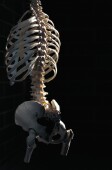Scoliosis: An Unnatural Curve
Treatment includes watchful waiting, bracing and, sometimes, surgery.
By Serena Gordon
HealthDay Reporter
|
E-mail this article
Subscribe to news
Printer friendly version
|

(SOURCES: Vincent Deeney, M.D., orthopaedic surgeon, Children's Hospital of Pittsburgh; John Grayhack, M.D., attending physician and orthopaedic surgeon, Children's Memorial Hospital, and professor, orthopaedic surgery, Feinberg School of Medicine, Northwestern University, Chicago)
SUNDAY, May 11 (HealthDay News) -- Human spines are naturally curved and flexible so that you can bend, twist, reach and more.
But, in some people, the natural curve of the spine doesn't develop properly and the spine takes on an "S" or "C" shape.
This condition is known as scoliosis and it affects about 6 million Americans, according to the National Scoliosis Foundation. While it isn't a dangerous or life-threatening condition, it can sometimes be uncomfortable. And for teens, it can be damaging to self-esteem.
"Scoliosis still carries a black cloud over it, but for the vast majority of children, it doesn't matter and they grow up fine," said Dr. John Grayhack, an attending physician and orthopaedic surgeon at Children's Memorial Hospital in Chicago.
Scoliosis is usually diagnosed between the ages of 10 and 15, according to the scoliosis foundation. If you have a family member who's had scoliosis, your odds of developing the disorder increase to one in five, instead of the usual one in 50, according to the American Academy of Orthopaedic Surgeons .
In most cases, the cause of scoliosis isn't known. However, there are two known causes of scoliosis: congenital and neuromuscular, according to the U.S. National Institutes of Health. In congenital scoliosis, a problem occurs in the womb when the spine is forming that causes it to develop with a curve. In neuromuscular scoliosis, the curve may be caused by poor muscle control or weakness from diseases such as cerebral palsy or muscular dystrophy. The muscles simply can't keep the spine in proper alignment. Later in life, scoliosis may occur as a result of osteoporosis.
Many children are unaware they have scoliosis. It's often discovered during a routine physical exam or at a scoliosis screening at school. Signs of scoliosis include a spine curving abnormally to the side, one shoulder appearing higher than the other, or the pelvis seeming out of alignment.
The diagnosis can usually be made from a physical exam, but most of the time, a spinal X-ray will also be done to confirm the diagnosis and more accurately assess the degree of the curve. Knowing the exact degree of the curve is important because it helps to guide treatment decisions.
"Right now, treatment is based on curvature," explained Dr. Vincent Deeney, an orthopaedic surgeon at Children's Hospital of Pittsburgh. For curves under 25 degrees, treatment is usually just observation, he said.
"For 25 to 40 degree curves, brace treatment isn't designed to get rid of a curve, but to keep it from getting worse," Deeney explained. There are a wide variety of braces available that shouldn't affect a child's social life, and they can be taken off so the child can participate in physical activities.
Both Deeney and Grayhack said that once a curve reaches 45 degrees, that's when it's time to consider surgery.
But, said Grayhack, "back surgery is a big deal. The surgery straightens out the spine and we try to hold it in place, usually with rods that are held in place with screws or hooks. The bone then fuses around the rods and you lose some flexibility in your spine."
Grayhack said some surgeons are using staples to straighten the back, and this method may help to maintain flexibility. But this is "cutting-edge" surgery right now, and not as well-studied as other methods, he noted.
There doesn't appear to be any way to prevent scoliosis, and Grayhack said that numerous studies have been done using exercise programs and other methods, but none has been found effective yet.
More information
To learn more about scoliosis, visit the American Academy of Orthopaedic Surgeons. 
Copyright © 2008 ScoutNews, LLC. All rights reserved. 
HealthDayNews articles are derived from various sources and do not reflect federal policy. healthfinder.gov does not endorse opinions, products, or services that may appear in news stories. For more information on health topics in the news, visit the healthfinder.gov health library.